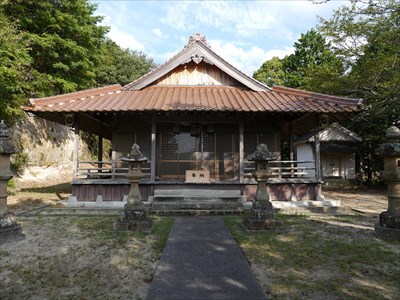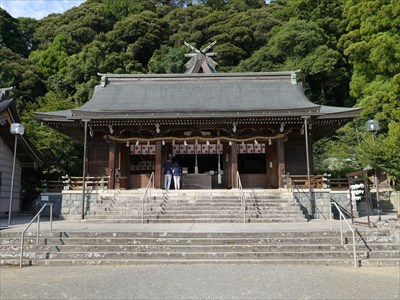| Home>Myth>Article |
Niikusohime as a dairy goddess
The following text is a slightly modified machine translation and may have some unnatural parts.
==Introduction==
If you go south on Route 375 in Oda City, you will find Mononobe Shrine, which is a few kilometers before the bus stop in front of Yoshinaga Shrine. The map says Yoshinaga Shrine, but you can easily see it because there is a banner that says "Niikusohime-no-Mikoto Shrine". The parking lot seems to have a parking space beside the shrine, but when I visited, I parked my car on the side of the road.

Niikusohime-no-Mikoto Shrine (Yoshinaga Shrine)

History of Niikusohime-no-Mikoto Shrine (Yoshinaga Shrine)
==The goddess of farming==
"新具蘇姫" is read as "Niikusohime". In other words, "kuso" is a poop. People may have felt the vitality there when they saw the seeds of the plants sprouted in the animal droppings. In recent years, it has been interpreted as the god of cheese and dairy farming because of the word "蘇 (so)".
If you read "Iwami Yae Mugura", a geography book of the Edo period, you can see that Niikusohime is equated with Haniyamahime. It is said that Haniyamahime was born from the stool that Izanami, who gave birth to Kagutsuchi, the god of fire, excreted on the bed of illness, so it may have been interpreted from there.
Katsuro Ishimura's "History Gleaning Izumo / Iwami" interprets "具蘇" as "貢蘇 (tribute so)" and the god of dairy products such as butter and cheese. "蘇 (so)" is boiled down milk, which is more like raw caramel.
There is a site called "Komainu Heaven", which introduces the contents of inquiries to the Oda City Board of Education about Niikusohime. In the olden days, people didn't avoid the word "kuso (feces)".
==History==
In ancient times, there was a theory that Mononobe clan settled in the present city of Oda to check Izumo, and it was a powerful theory before the war. However, according to the new edition of Shimane prefecture history, the area around Mononobe Shrine is the earliest area in Iwami Province that has the conditions for establishing a rural area. Probably the settlement was established in the early Yayoi period, and they think that it is not the place to be cultivated until Mononobe clan settled. In other words, the interpretation is that the inhabitants of this region were incorporated as the people of the Mononobe clan.

Mononobe Shrine
Yoshinaga, where Niikusohime-no-Mikoto Shrine is located, is not far from Mononobe Shrine, and this area may have been cultivated from an early stage.
Niikusohime-no-Mikoto Shrine is one of the Iwami country shikinai shrines (the old and officially certified shrines).
==Creative folk tale==
There is no legend about Niikusohime, but I tried to create it by telling a story.
A long time ago, there was a small domain called Kato domain in Yoshinaga, Oda City. At one point, many cattle in western Japan died due to an infectious disease called rinderpest that was transmitted from abroad. Cows at that time were a valuable labor force and a property of the house. The troubled people consulted with each other. At one point, a goddess appeared in the dream of the Kato feudal lord and told him that he should cut open the foot of Mt. Sanbe and raise cows there. So the lord carved out the foot of Mt. Sanbe and bought a breeding cow from Kansai to raise a calf. Then the number of cows increased again. The goddess that appeared in the dream of the lord seems to be the god of Yoshinaga Shrine. That's why people enshrined Niikusohime grandly. A lot of old days.
…… It incorporates the history of Mt. Sanbe, but it is just a creation. Feel free to talk, but I would like to mention that it is a creative folk tale that I thought about in the last year of Heisei.
==Digression==
There are also Sahime and Kahime, and since it is the god of So (蘇), I think it should be called Sohime.
==References==
- * 『歴史の落穂拾い 出雲・石見』(石村禎久[勝郎], 石村勝郎, 2000)pp.51-55, 170-173
- * 『島根の神々』(島根県神社庁, 福間秀文堂, 1987)
- * 『角鄣経石見八重葎』(石見地方未刊行資料刊行会/編, 石見地方未刊行資料刊行会, 1999)
- * 『新修島根県史 通史篇 1 考古・古代・中世・近世』(島根県, 臨川書店, 1984)